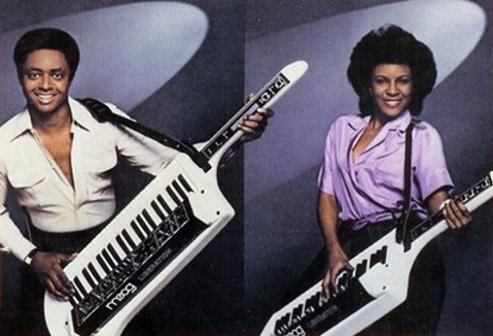Well, technically I “DuckDuckGo’d” it (“DuckDuckWent” it?) because I endorse DuckDuckGo for numerous privacy reasons. But I mostly ended up on YouTube anyway, negating any of that. The question of the day: Why a keytar? Is there a legit musical reason to use one, or are they just bitchin’? (Which is a perfectly good reason.)
Anyway the first thing that came up was in the genre of “home musician plays along with a song.” (A genre I estimate to comprise 40% of YouTube content and 1% of its views.) Here, a guy uses his keytar to recreate Slash’s solo from Guns N’ Roses’ “Sweet Child o’ Mine”:
Why did this come up? Is it a “sweet” keytar solo? The performance is fairly tentative, probably he’s just comfortable enough with it to roll camera. But it sounds great! So I’m fine with the adjective being used here, but honestly it came up because of the song title. Everyone learns a lesson about metadata.
Did I learn anything about the keytar? In fact, I did! I now understand it has its own version of a whammy bar and a way to create a vibrato effect like you could do if playing strings.
I have only myself to blame, but I the particular adjective I thought to use meant I just had to skip a bunch of competing versions of “Sweet Child o’ Mine”. Here was the first non-GNR solo:
A short one by a guy in his basement wearing pajamas. But pretty enjoyable video game music.
Did I learn anything about the keytar? I’m starting to understand the big question of the day. It’s somewhere in the liminal space between guitar and keyboard. If you want a keyboard sound, with guitar-like effects, this is the way to go. But I don’t know why you can’t just do this on a regular keyboard. I think you can, but it doesn’t look so boss. Like this:
Here I learned about the Finnish metal band Sonata Arctica and maybe the best keytarist in the world, Henrik Klingenberg. Wikipedia tells me he likes the keytar so he can wander around the stage as the mood strikes him, like the rest of the musicians. (Well, sorry drummers.) He also says his musical inspiration is taken from “life itself.” Only a keytar was going to allow Henrik to fulfill his musical vision.
Or maybe the best keytarist is…Belinda Bedekovic?
She’s Croatian and though maybe not as skilled as Henrik, I posit that she better captures the keytar zeitgeist, such as it is. I won’t link to it (you all know how the internet works) but I quickly discovered her Instagram account in which she poses in various states of undress, usually with her keytar. For no clear reason most of these pictures are actually displayed on her computer monitor, and the IG post is a snapshot of the monitor. Listen, if it leads to keytar inspiration, I am for it.
Conclusions: Why a keytar?
Interestingly, I think the keytar exists in two cultural spaces at once, which are typically separate. One: keytars are weird and stupid and should be laughed at, e.g., “Keytar Sales Down for the 425th Straight Month”. (I would totally buy a keytar for $14, btw.) And yet, e.g. “Rebirth of the Keytar!” So they are the dumbest thing, but still cool. Perhaps this is another extension of the increasingly pervasive dominance of what was once waved off as “nerd culture.”
So I don’t have a straightforward answer to articulate, but I am satisfied keytars are not simply for decoration. They are not guitars, and they are not keyboards. This is by design. They have a particular sound and feel. If you need one, you’ll know it, the same way you’d know the xylophone or cello was the right instrument for a particular task. Can you say that about a French horn? I can’t. I don’t know what they are for. Maybe next time I will DuckDuckGo the French horn.

French Horns are for the Wolf in “Peter and the Wolf”. And for John Entwistle.